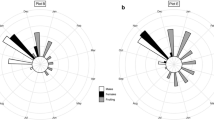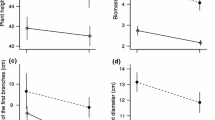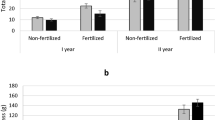Abstract
Under dry environmental conditions the sex ratio of many dioecious plants is male-biased, which is usually explained by the higher susceptibility of females to drought stress. We investigated if spatio-temporal variation in the sex ratio ofSilene otites could be explained by the higher sensitivity of female plants to drought stress as compared to males. Long-term field observations, however, did not support this hypothesis. The sex ratio in 34 patches at the study site in Central Germany changed from slightly female biased in 1994 to strongly male-biased in 1997 and 1998. The interannual change in the proportion of plants that were female was positively correlated with the number of days with soil-water deficit in the late summer, suggesting higher mortality in males than in females under drought stress. In two closely studied patches, mortality in males was also higher than in females, although this difference could not be related to drought stress. These field observations were supported by an experiment with potted plants in two climate chambers, in which male mortality was higher during a three-week period without water supply. We conclude that the often reported male bias in patches ofS. otites is not caused by sexual differences in the sensitivity to drought stress. Field data in this study, however, suggest that maleS. otites plants flower earlier than females, which causes a shift in sex ratio to more male bias among flowering plants.
Similar content being viewed by others
References
Bierzychudek P. &Eckhart V. (1988): Spatial segregation of the sexes of dioecious plants.Amer. Naturalist 132: 34–43.
Blackburn K.B. (1929): On the occurrence of sex chromosomes in flowering plants with some suggestions as to their origin.Proc. Int. Congr. Pl. Sci. 1: 299–309.
Brantjes N.B.M. &Leemans J.A.A.M. (1976):Silene otites (Caryophyllaceae) pollinated by nocturnal lepidoptera and mosquitoes.Acta Bot. Neerl. 25: 281–295.
Correns C. (1928): Bestimmung, Vererbung und Verteilung des Geschlechtes bei den höheren Pflanzen. In:Baur E. &Hartmann M. (eds.),Handbuch der Vererbungswissenschaft, Borntraeger, Berlin, pp. 1–138.
Dawson T.E. &Ehleringer J.R. (1993): Gender-specific physiology, carbon isotope discrimination, and habitat distribution in boxelder,Acer negundo. Ecology 74: 798–815.
Degraeve N. (1980): Étude de diverses particularités caryotypiques des genresSilene, Lychnis etMelandrium.Bol. Soc. Brot., Ser. 2 53: 595–643.
Faegri K. &van der Pijl L. (1971):The principles of pollination ecology. Ed. 2. Pergamon, Oxford.
Freeman D.C., Harper K.T. &Charnov E.L. (1980): Sex change in plants: old and new observations and new hypotheses.Oecologia 47: 222–232.
Freeman D.C., Lovett-Doust J., Keblawy A.E., Miglia K.J. &McArthur E.D. (1997): Sexual specialization and inbreeding avoidance in the evolution of dioecy.Bot. Rev. 63: 65–92.
Freeman D.C., McArthur E.D., Sanderson S.C. &Tiedemann A.R. (1993): The influence of topography on male and female fitness components ofAtriplex canescens.Oecologia 93: 538–547.
Hegi G. (1979):Illustrierte Flora von Mitteleuropa 3/2. Paul Parey, Berlin.
Hemborg A.M. &Karlsson P.S. (1999): Sexual differences in biomass and nutrient allocation of first-yearSilene dioica plants.Oecologia 118: 453–460.
Hermanutz L.A. &Innes D.J. (1994): Gender variation inSilene acaulis (Caryophyllaceae).Pl. Syst. Evol. 191: 69–81.
Knuth P. (1898):Handbuch der Blütenbiologie 2/1. Verlag von Wilhelm Engelmann, Leipzig.
Lloyd D.G. (1974): Female predominant sex ratios in angiosperms.Heredity 32: 35–44.
Lovett Doust J., O’Brien G. &Lovett Doust L. (1987): Effect of density on secondary sex characteristics and sex ratio inSilene alba (Caryophyllaceae).Amer. J. Bot. 74: 40–46.
Lyons E.E., Miller D. &Meagher T.R. (1994): Evolutionary dynamics of sex ratio and gender dimorphism inSilene latifolia: I. Environmental effects.J. Heredity 85: 196–203.
Mahn E.-G. (1965): Vegetationsaufbau und Standortsverhältnisse der kontinental beeinflussten Xerothermrasengesellschaften Mittel-deutschlands.Abh. Sächs. Akad. Wiss. Leipzig, Math.-Naturwiss. Kl. 49: 1–138.
Mulcahy D.L. (1967): Optimal sex ratio inSilene alba.Heredity 22: 411–423.
Müller J., Schumann A. &Jörn P. (1998): Zur Häufigkeit von Bodendürren im mitteldeutschen Trockengebiet.Ann. Meteorol. 37: 167–168.
Nicotra A.B. (1998): Sex ratio variation and spatial distribution ofSiparuna grandiflora, a tropical dioecious shrub.Oecologia 115: 102–113.
Sansome F.W. (1938): Sex determination inSilene otites and related species.J. Genet. 35: 387–396.
Scutt C.P., Robertson S.E., Willis M.E. &Gilmartin P.M. (1997): Sex determination in dioeciousSilene latifolia. Effects of the Y chromosome and the parasitic smut fungus (Ustilago violacea) on gene expression during flower development.Pl. Physiol. 114: 969–979.
Shea M.M., Dixon P.M. &Sharitz R.R. (1993): Size differences, sex ratio, and spatial distribution of male and female water tupelo,Nyssa aquatica (Nyssaceae).Amer. J. Bot. 80: 26–30.
Soldaat L.L., Vetter B. &Klotz S. (1997): Sex ratio in populations ofSilene otites in relation to vegetation cover, population size and fungal infection.J. Veg. Sci. 8: 697–702.
Taylor D.R. (1994): The genetic basis of sex ratio inSilene alba (=latifolia).Genetics 136: 641–651.
Weeda E.J., Westra R., Westra Ch. &Westra T. (1985):Nederlandse Oecologische Flora. Wilde planten en hun relaties (Dutch ecological flora. Wild plants and their elationships). IVN, Amsterdam.
Westergaard M. (1958): The mechanism of sex determination in flowering plants.Advances Genet. 9: 217–281.
Author information
Authors and Affiliations
Rights and permissions
About this article
Cite this article
Soldaat, L.L., Lorenz, H. & Trefflich, A. The effect of drought stress on the sex ratio variation ofSilene otites . Folia Geobot 35, 203–210 (2000). https://doi.org/10.1007/BF02803098
Issue Date:
DOI: https://doi.org/10.1007/BF02803098




